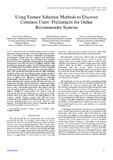Using Feature Selection Methods to Discover Common Users’ Preferences for Online Recommender Systems

View/
Date
2021-01Author
Ndung'u, Rachel N.
Kamau, Gabriel N.
Wambugu, Geoffrey M
Metadata
Show full item recordAbstract
Recommender systems have taken over user’s choice to choose the items/services they want from online markets, where lots of merchandise is traded. Collaborative filtering-based recommender systems uses user opinions and preferences. Determination of commonly used attributes that influence preferences used for prediction and subsequent recommendation of unknown or new items to users is a significant objective while developing recommender engines. In conventional systems, study of user behavior to know their dis/like over items would be carried-out. In this paper, presents feature selection methods to mine such preferences through selection of high influencing attributes of the items. In machine learning, feature selection is used as a data pre-processing method but extended its use on this work to achieve two objectives; removal of redundant, uninformative features and for selecting formative, relevant features based on the response variable. The latter objective, was suggested to identify and determine the frequent and shared features that would be preferred mostly by marketplace online users as they express their preferences. The dataset used for experimentation and determination was synthetic dataset. The Jupyter Notebook™ using python was used to run the experiments. Results showed that given a number of formative features, there were those selected, with high influence to the response variable. Evidence showed that different feature selection methods resulted with different feature scores, and intrinsic method had the best overall results with 85% model accuracy. Selected features were used as frequently preferred attributes that influence users’ preferences.
Collections
- Journal Articles (CI) [141]
